Parrot fish are a species that has very peculiar characteristics in addition to a somewhat strange beauty. Apart from this there is a great variety of specimens in this family: there are more than eighty species of parrot fish. Today you will know everything related to this distinctive fish, let’s start.

Table Of Content
- 1 Taxonomy 🐠
- 2 The Peculiar Parrotfish 🐠
- 3 General Characteristics 🐠
- 4 Where do Parrot Fish Inhabit? 🐠
- 5 Behavior 🐠
- 6 The Parrot fish are Hermaphrodite! 🐠
- 7 What do Parrot Fish Eat? 🐠
- 8 How Parrot Fish Reproduce? 🐠
- 9 What are they Dangers? 🐠
- 10 Types of Parrot Fish 🐠
- 10.1 Green humphead (Bolbometopon muricatum) 🐠
- 10.2 Biology. 🐠
- 10.3 Blue parrotfish (Scarus coeruleus) 🐠
- 10.4 Distribution and Habitat of Blue Parrotfish
- 10.5 Rainbow parrot fish (Scarus guacamaia) 🐠
- 10.6 Habitat
- 10.7 Stoplight Parrotfish (Sparisoma viride) 🐠
- 10.8 Princess Parrotfish 🐠
- 10.9 Scarus coelestinus. (Midnigh parrot fish) 🐠
- 11 Parrotfish in Captivity 🐠
- 12 Are Parrot Fish Edible? 🐠
- 13 Cichlid Parrot Fish 🐠
Taxonomy 🐠
Kingdom: Animalia Phylum: Chordata Class: Actinopterygii Order Labriformes Family: Scaridae 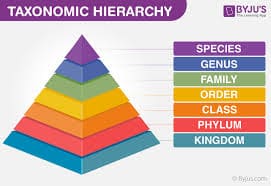
The Peculiar Parrotfish 🐠
Like zebra fish, parrot fish are tropical fish belonging to the perciform order and very similar to those of the Labridae family.
They are very much appreciated in aquarium hobby since they have a truly extraordinary range of colors.
Their scientific name is Scaridae, and they have some very distinctive characteristics in each of their varieties. Let’s first know the general features that these fish have. We invite you to read our article clown fish to learn more about perciform fish
General Characteristics 🐠
An average adult of this species usually measures about 90 centimeters in length and weighs around 30 kilograms.
 Their body is covered with large cycloid scales, that is, arranged so that their surfaces overlap each other, so that together they form a relatively smooth surface as well as bright and contrasting colors that often form a characteristic pattern of dots, spots and stripes.
Their body is covered with large cycloid scales, that is, arranged so that their surfaces overlap each other, so that together they form a relatively smooth surface as well as bright and contrasting colors that often form a characteristic pattern of dots, spots and stripes.
Red, blue, yellow, gray, brown and black are the most common colors in this family. In some species the scales are so thick that it’s said that they can stop the impact of a spear.
It’s worth mentioning that they have a parrot-like denture and hence the origin of their name. They are teeth grouped in a compact package that fuse and give the beak shape.
Parrot fish also have a dorsal fin of 9 spines, an anal fin with three and finally the pelvic fin has only one spine.
Other data of interest 🐠
Parrot fish are highly prized due to their ecological impact on coral reefs, since they contribute to the creation of sediments in them.
It’s estimated that within a year, a fish is only able to turn a vast area of coral into sand. We invite you to read our article the anatomy of fish to learn about such an interesting topic
Let’s enjoy them
Where do Parrot Fish Inhabit? 🐠
Parrot fish are distributed in the Pacific, the Indian, the Atlantic and the Red Sea mainly in warm waters. They usually live in transparent lagoons and offshore reefs and can submerge until they reach 30 meters deep. 
They are a very abundant species in tropical waters, also in subtropics, but they don’t inhabit deep waters.
The reef areas are their favorite, however some species are found in areas with seagrass. they are common in the Caribbean and some rocky shores.
Behavior 🐠
Parrot fish are very social animals that live in groups of several females submitted by a single male. It’s also common to see them making-up groups of up to forty specimens looking for food together in the vicinity of coral reefs.
In some cases the groups are directed by a reproductive male also known as the super male who in most cases is a female who has reversed her sex.
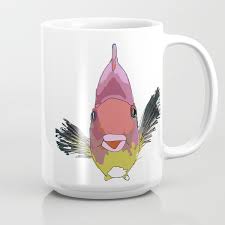 Yes, it’s possible since the parrot fish have the peculiarity that they can change sex since when the male dies or for some reason disappears, the dominant female of the group proceeds to replace him, making the sex change and taking the functions of the boss of the collective.
Yes, it’s possible since the parrot fish have the peculiarity that they can change sex since when the male dies or for some reason disappears, the dominant female of the group proceeds to replace him, making the sex change and taking the functions of the boss of the collective.
The inverted female totally changes her appearance and is usually very territorial, the behavior is as varied as her appearance is.
Young specimens like to swim alone when they are adults. They start swimming in small groups employing their dorsal fins..! It’s very weird when they use their tail!
Some species are extremely territorial, but others are nomadic fish that don’t defend any specific territory.
Other Facts 🐠
It’s worth mentioning that the larger the specimen, the wider its range of habitat will be, that is, the area through which they move.
Another interesting fact is that they are diurnal fish that have more activity during the daylight hours, while at night they rest in the corners of the reefs or bury themselves in the sand.
A peculiarity of these fish is presented by the Scaru Vetula variety which secretes a kind of mucus before sleep that transforms into a cocoon which envelops its entire body. It’s thought to be a way to protect itself from predators because this substance hides its smell.
Let’s enjoy them again
The Parrot fish are Hermaphrodite! 🐠
As we indicated earlier, the female has the ability to change sex, since the species is a protogynous hermaphrodite, that is, they begin their life as a female to end up as males. The fish that are born male are dominant males, while the fish that are more territorial were previously females.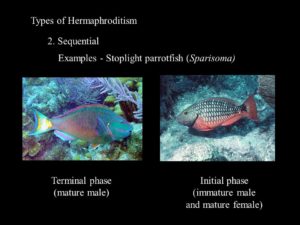
There are two reasons why the female changes sex, the first is for the death or disappearance of the dominant male to meet the needs of the other females of the harem, whether for protection, feeding or reproduction.
In other cases, such as in the Leptoscarus vaigiensis species, the female doesn’t change sex because of the disappearance of the male but for leading the group even if there are males in it.
What do Parrot Fish Eat? 🐠
Parrot fish are herbivores that mainly consume microscopic organisms and sponges. Their favorite foods are dead algae that are located in corals that are released from the reef.
Their way of eating is peculiar and functional for the ecosystem since to feed they use their strong  teeth to crush the calcareous material and be able to reach the algae.
teeth to crush the calcareous material and be able to reach the algae.
When they do they consume some coral, and when this material reaches their pharynx it’s already ground and processed in a kind of fine paste.
Once inside the fish, the algae cells separate and digestion occurs. The coral is digested and expelled by the feces in the form of sand that is placed around the reef creating in this way a spectacular place.
Let’s enjoy them again
How Parrot Fish Reproduce? 🐠
Very little is known about this process, it’s only known that they are pelagic spawners, that is, they gather in some area of the ocean to lay their eggs so that the current can be transported by open sea once they have been fertilized.

In the initial phase the males join the group to fertilize the eggs attracting the females through their bright colors, spawning occurs at sunset.
When the eggs hatch, the larvae float in the epipelagic zone near the surface
When they exceed twelve centimeters they are already considered young fish and come down to live in the reef.
The parrotfish is only able to reproduce when it’s more than 60 centimeters in length, it has a life expectancy of 40 years and grows to 1.3 meters. Taking these factors into account, the replacement of the species is considered slow.
What are they Dangers? 🐠
Mainly they are the human beings and in certain occasions they are attacked by sharks. These fish return at night to sleep always in the same place and all together which makes them easy to catch.
Additionally, they are in great demand in the aquarium trade. Parrot fish are also captured for traditional ceremonial events and have a high cultural value for certain communities.
Some people consume their meat which is considered a delicacy in Polynesia where it’s served raw and is classified as a food for royalty.
In some countries regulations have been developed that prohibit the use of fishing spear and night fishing of this species.
It’s also worth mentioning that the parrotfish is classified as vulnerable by the global union for nature.
The slow growth and late reproduction of this species result in a very slow replenishment that makes the fish very vulnerable to overfishing.
The biggest problem arises due to commercial freckle and assisted underwater fishing, which almost completely eliminates parrotfish in the Fji Islands. This island obtains great profit derived from tourist diving for this reason they protect their reefs a lot.
Types of Parrot Fish 🐠
Let’s meet some of the most popular species within this family
Green humphead (Bolbometopon muricatum) 🐠
This is the largest of all parrot fish. Bolbometopon muricatum, is a slate gray, olive green or blue fish, with a pink or yellowish head. Its most distinctive feature and the reason for its common name is the bulbous bump on the forehead that adults develop.
Young specimens lack this bulky head and also differ slightly in color.
They are green or brown with five vertical rows of small whitish spots.
It receives its name for the peculiar teeth that merge into a parrot’s beak. They also have teeth in the back of the throat with which they crush food. Its size is up to 130 cm and weigh about 46 kgms
Biology. 🐠
The green humphead is always found in small groups, sometimes no more than 75 individuals. It feeds on live corals and algae that grow at the bottom of the ocean and uses its large bulbous head to ram the coral and divide it into smaller and easier to digest parts.
 Its bird-shaped mouth and the front and pharyngeal teeth at the back of the throat allow them to eat this food, pulverize the hard coral until it forms a paste and break up the algae. Any hard material that is not nitritive is removed through feces.
Its bird-shaped mouth and the front and pharyngeal teeth at the back of the throat allow them to eat this food, pulverize the hard coral until it forms a paste and break up the algae. Any hard material that is not nitritive is removed through feces.
It’s estimated that an adult consumes five to six tons of coral each year, produce large amounts of sediment and influence the structure of coral reefs, thus playing an important role in such ecosystems.
The green humphead can be found in tropical and subtropical coral reefs in the western Pacific, the Indian Ocean and the Red Sea.
Let’s watch them
Blue parrotfish (Scarus coeruleus) 🐠
The blue parrot fish is an almost completely bright blue fish, typical of the species of parrot fish of the genus Scarus. .
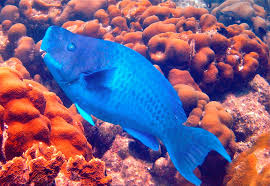 When they are young, they have a yellow spot on the head that, as they grow, fades into a purple color until it reaches deep blue. This species has a life expectancy of approximately 20 years.
When they are young, they have a yellow spot on the head that, as they grow, fades into a purple color until it reaches deep blue. This species has a life expectancy of approximately 20 years.
The adult specimens measure between 30 and 100 centimeters in length with an approximate weight of 30 kilograms. Males are larger than females in most cases, which also tend to develop humps on the head.
The parrot name refers to its beak-shaped jaw, since the teeth have them fused together. These teeth are used to scrape algae from rocks and corals.
They also have pharyngeal teeth, which are the teeth that are inside the throat. Parrot fish use these teeth to crush the rocks and corals they eat, which they defecate in the form of white sand.
This sand is what we found in tropical beaches. For this reason, parrotfish contribute to the formation of sediments that make up the small islands and sandy beaches in the Caribbean. Each parrotfish can produce up to 450 grams of sand per year.
Distribution and Habitat of Blue Parrotfish
They are distributed in much of the western Atlantic, from Maryland (United States), Bermuda and Bahamas to Rio de Janeiro (Brazil), including the West Indies, although they are absent in the north of the Gulf of Mexico.
The blue parrotfish inhabits coral reefs at depths between 3 and 40 meters. Juveniles are located in seaweed beds and mangroves.
Rainbow parrot fish (Scarus guacamaia) 🐠
The rainbow parrot fish (Scarus guacamaia) is the largest of the Atlantic herbivorous fish, males exceed 1.2 meters in length. As the name implies, they are attractive fish with dark  green bodies. The fins are orange with green streaks that extend outward, the back and the tail. Males can be of two forms: in the initial phase they are gray and similar in appearance to females, while in the adult phase they are brightly colored. Its size is up to 120 cm and its weight up to 20 gms
green bodies. The fins are orange with green streaks that extend outward, the back and the tail. Males can be of two forms: in the initial phase they are gray and similar in appearance to females, while in the adult phase they are brightly colored. Its size is up to 120 cm and its weight up to 20 gms
Habitat
The rainbow parrot fish is found in the western Atlantic, from Florida, Bermuda and the Bahamas to Argentina. They are associated with coral reefs at depths of 3 to 25 meters.
At night, the rainbow parrot fish takes refuge in the cracks. The young tend to be in the mangroves adjacent to the reefs. Mangroves act as important breeding grounds and provide the young with safe food and shelter against predators.
Stoplight Parrotfish (Sparisoma viride) 🐠
The stoplight (Sparisoma viride) grows to between 12-18 inches and is usually found in coral reefs throughout Bermuda, Florida, Caribbean Sea, Gulf of Mexico and as far south as Brazil. As a juvenile the fish looks a lot different to the matured adult.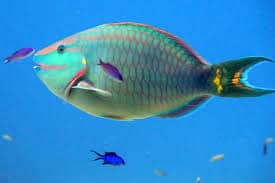
In the initial phase they are red and white, and can rapidly change the color of their scales on the underside of their body.
They get their name from the yellow spot near their pectoral fin, which is only visible once fully matured.
Princess Parrotfish 🐠
This parrot fish can reach a maximum size of 35 centimeters. Its appearance varies throughout life. Juveniles and young adults are dark olive colored, with two broad bands on each side: the upper one, from the tip of the snout, through the eye, to the middle of the base of the caudal fin, and the lower one from the Chin, through the base of the pectoral fin, to the base of the caudal.
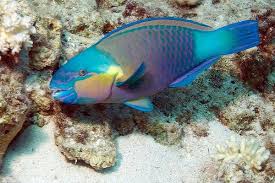 Above the upper band appears a white area that extends across the forehead and below the eye.
Above the upper band appears a white area that extends across the forehead and below the eye.
The adults in terminal phase have a more bluish coloration, with the edges of the fins orange in color forming transverse crescents; an orange spot from the pectoral fin to the middle of the body, and two more intense blue bands from the top of the snout to fade at the height of the pectoral fin.
Adults are on coral or rocky bottoms, while juveniles prefer areas with vegetation (Thalassia). They feed on plant products and algae, usually in large groups. To spend the night, they tend to make mucus beds.
They are distributed at low depth in the tropical and subtropical waters of the Western Atlantic, from southern Florida and the Bahamas, to Brazil, including the Caribbean Sea.
Let’ smeet them
Scarus coelestinus. (Midnigh parrot fish) 🐠
Also known as Scarus coelestinus lives mainly in the Caribbean, The Bahamas and Florida. They usually measure between 30 and 60 centimeters and sometimes reach up to 90 meters.
Midningh parrotfish usually submerge from three meters to the eighties, and swim over the reef and sandy areas feeding mostly on algae. They have black and blue tones.
Parrotfish in Captivity 🐠
Although due to their striking colors many people are attracted to this species, it must be taken into account that its maintenance in an aquarium is extremely difficult. On the one hand, they need to eat live coral to grow conveniently and, in addition, they lose the intensity of the colors.
Curiosities
Parrot fish are difficult to keep in aquariums because they constantly need to feed on coral rocks so that their teeth don’t grow too much. Generally, the amount of algae that grows in home aquariums is not enough for the maintenance of the parrotfish. If the parrotfish cannot file the beak by scraping algae from the coral, it will continue to grow.
The parrotfish descends from the budion and shares many of its characteristics, such as reproduction. These two groups have differences in teeth, digestive system and eating habits.
Are Parrot Fish Edible? 🐠
The answer is no and here are the reasons
✅ Parrot fish «unload» up to 100 kg of white sand per year for each year of their lives.The largest parrot fish are like sand mills, producing more than a ton of sand per year.
The University of Exeter established that parrot fish produce more than 85% of the new sand sediments in the Maldives reefs.
When we consider the impact for thousands of years, imagine the amount of beautiful white sand that parrot fish could produce if they were allowed to live and not be consumed. This is very important to prevent erosion of beaches.
✅ Parrot fish are also essential for coral survival, as they act as «natural cleansers» of the parasites that grow in them.Without the help of the parrot fish the coral would simply die.
According to a 2012 study, the loss of parrot fish disrupts the delicate balance of coral ecosystems and allows the algae, from which they feed, not to stifle the reefs.
The study also demonstrated the loss of 50% of corals in the Caribbean since the 1970s and predicts that they could go as far as disappearing in the next 20 years.
This would be a direct consequence of the loss of parrot fish and sea urchins – two major herbivores in the area – and not only due to climate change, as is popularly believed.
The study also shows that some of the healthiest coral reefs in the Caribbean are those located in areas where governments «have restricted or banned fishing practices that harm parrotfish, such as fish traps and underwater fishing.» .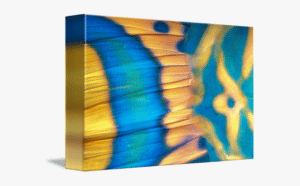
✅ The economy: Coral reefs help build and protect the beautiful white sand beaches of the Dominican Republic, which attract tourists from around the world.
The reefs provide a critical habitat for artisanal and industrial fisheries in the Dominican Republic, and also protect the coasts, including coastal communities and tourist hotels. In other words, eating parrotfish has a direct impact on the economy.
Tourists travel to the Dominican Republic through the sand and the sea. Tourism depends on the beaches, and the beaches depend on the coral, all possible thanks to this voracious species. By consuming parrot fish, we steal the sandy beaches and, in turn, damage the economy.
Let’s enjoy them one more time
Cichlid Parrot Fish 🐠
Yes, there is a small fish that is a hybrid created by man in a laboratory which has no scientific name. We are going to know a little about this species which only shares its name with our parrotfish which we have been studying. This other species has no natural habitat since its creation was by manipulation of its genes.
Description 🐠
It’s also known as blood Parrot Cyclid as it appears and is a fish with a rounded shape just like the Amazonian Disc, but it has a disproportion between the head and its Dorsal fin.
Some specimens have a stomach displaced and contracted by their swim bladder. It also has a deviated spine and a deformed mouth which they cannot close completely.
In some specimens the operculums don’t cover the gill, which leaves the fish exposed to a large number of infections. Some of their individuals show an abnormality in the eyes as they are raised in the laboratory.
Behavior 🐠
 The cyclid parrotfish is territorial, curious and very sociable and relates well to any species found in the aquarium such as other large cichlids, the zebrafish, among others. He usually establishes relationships with the person who feeds him.
The cyclid parrotfish is territorial, curious and very sociable and relates well to any species found in the aquarium such as other large cichlids, the zebrafish, among others. He usually establishes relationships with the person who feeds him.
It’s worth mentioning that it’s a playful fish that usually chases smaller fish, but without hurting them. On certain occasions he defends his aquarium mates.
It’s an omnivorous fish that feeds on everything that is given, although it usually rejects lettuce and similar vegetables.
It’s also difficult for him to eat due to his deformed mouth; it’s possible that other faster fish take away his food. We invite you to read our article blood parrot ciclid to get a comprehensive description of this species…
Let’s watch them
